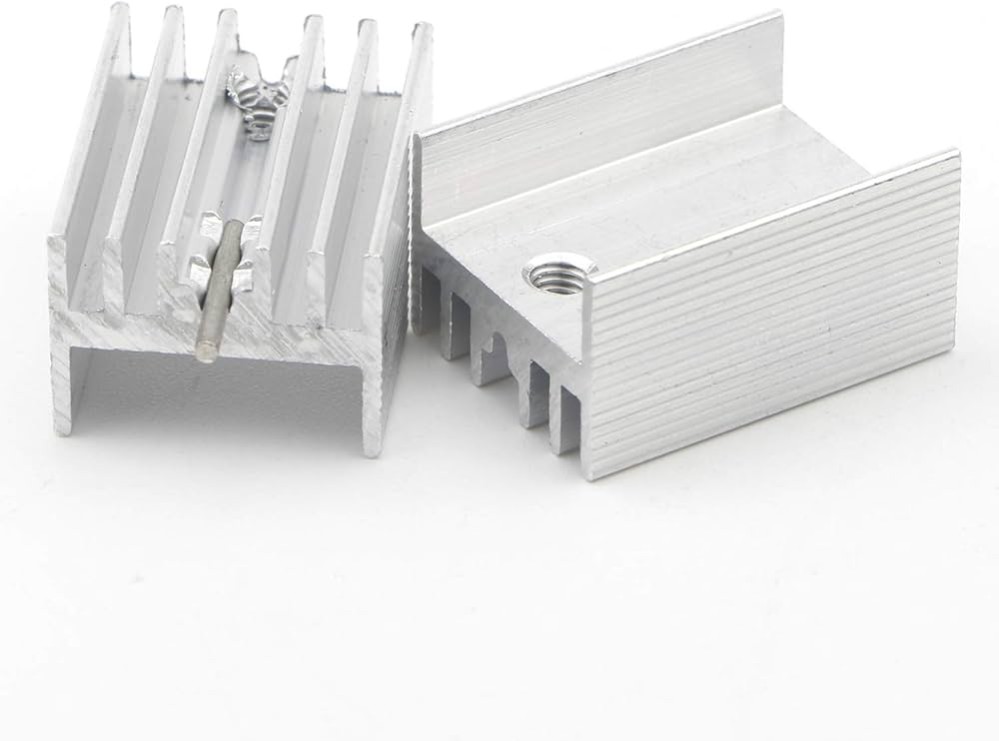








7805 HEAT SINK
Generally used to keep voltage regulators and motor drivers cool, efficient and increases reliability of the components.
₹ 10 ₹19
19
Add FAQ
A 7805 heat sink refers to a heat dissipation accessory designed to be attached to a 7805 voltage regulator to prevent overheating. The 7805 is a linear voltage regulator that provides a stable 5V output from a higher voltage input, commonly used in electronics, including microcontrollers and various power supply systems.
When the 7805 voltage regulator operates, it can generate a significant amount of heat, especially when there is a large difference between the input and output voltage or when the regulator is supplying a higher current. This is why a heat sink is often used to manage the excess heat and ensure the safe and efficient operation of the voltage regulator.
Key Details and Features of a 7805 Heat Sink:
-
Purpose of the Heat Sink:
- Heat Dissipation: The primary function of a heat sink is to dissipate heat away from the 7805 regulator to prevent it from overheating. This helps maintain stable performance and prevents thermal shutdown, which can occur when the regulator reaches a certain temperature threshold.
- Thermal Management: The heat sink increases the surface area of the 7805, allowing for better heat conduction into the surrounding air.
-
When to Use a Heat Sink:
- High Input Voltage: When the input voltage is significantly higher than 5V, such as 12V or 15V, the 7805 has to drop a large voltage difference, resulting in more heat generation.
- High Current Load: If the 7805 is supplying high current (greater than 1A), it will generate more heat, necessitating the use of a heat sink.
- Long Operation: In applications where the regulator is on for extended periods, heat management becomes crucial to ensure the system runs reliably.
-
Heat Sink Characteristics:
- Material: Typically, heat sinks are made from materials with good thermal conductivity, such as aluminum or copper, as they can effectively transfer heat away from the 7805.
- Size: The size of the heat sink depends on the power dissipation requirements of the 7805. Larger heat sinks are needed for higher power dissipation. The heat sink should cover the surface area of the TO-220 package (the typical package for the 7805) and might extend in size for higher performance.
- Mounting: Heat sinks typically have a flat surface that makes contact with the 7805's metal tab (the tab on the package is typically the thermal connection to the internal components). The heat sink is mounted using thermal paste or thermal adhesive to improve heat transfer, or it may clip onto the 7805 using a spring-loaded clip or screw mounting.
-
Choosing the Right Heat Sink:
- Thermal Resistance: Heat sinks are rated by their thermal resistance (typically in °C/W). A lower thermal resistance value means that the heat sink is more effective at dissipating heat. The size and material of the heat sink influence this rating.
- Power Dissipation: Calculate the amount of heat the 7805 will generate by using the formula: P=(Vin−Vout)×IoutP = (V_{in} - V_{out}) imes I_{out} where VinV_{in} is the input voltage, VoutV_{out} is the output voltage (5V for the 7805), and IoutI_{out} is the output current. The higher the power dissipation (P), the larger and more efficient the heat sink needs to be.
- Airflow and Environment: Consider the airflow and the environment in which the 7805 will be used. A fan or active cooling may be necessary if the heat dissipation requirements are high.
-
Installation:
- Clean the surface of the 7805 regulator and the heat sink to remove any dirt or oils.
- Apply a thin layer of thermal paste to the metal tab of the 7805 to improve heat transfer.
- Attach the heat sink securely using a clip or screw.
- Ensure there is enough space for airflow around the heat sink to further enhance cooling.
Conclusion:
A 7805 heat sink is an important accessory for ensuring the stable operation of the 7805 voltage regulator when it's operating under conditions that generate significant heat. By dissipating excess heat, the heat sink prevents the regulator from overheating and ensures that it continues to provide stable 5V output for your circuits. When selecting a heat sink, consider factors like power dissipation, size, material, and thermal resistance to ensure efficient cooling.
0 Reviews For this Product












2.jpeg&width=225&quality=80)
2.jpeg&width=225&quality=80)
.jpeg&width=225&quality=80)

